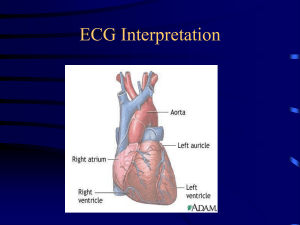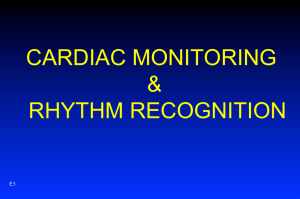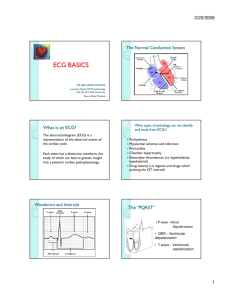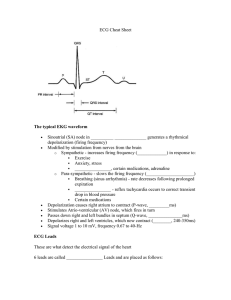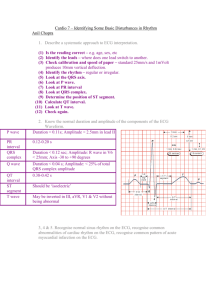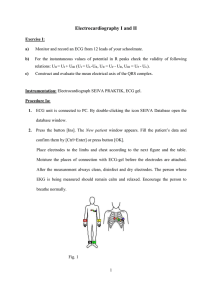Master ECG Module
advertisement
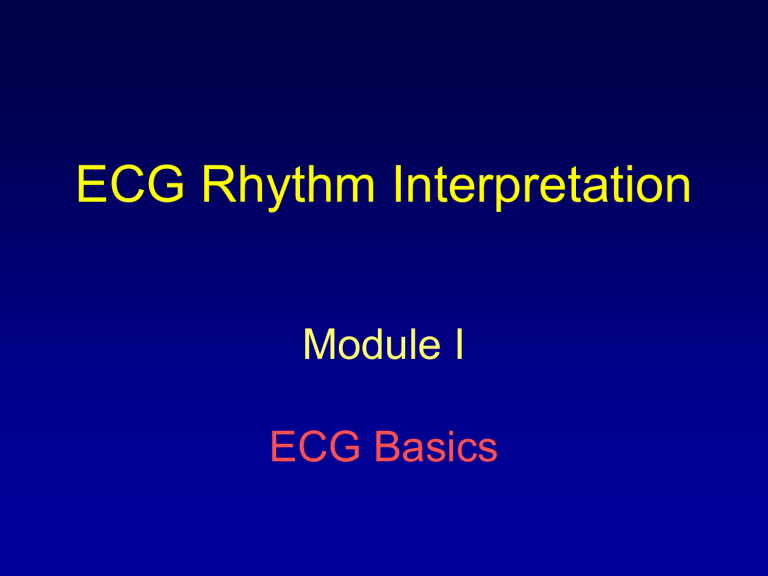
ECG Rhythm Interpretation Module I ECG Basics Course Objectives • To recognize the normal rhythm of the heart - “Normal Sinus Rhythm.” • To recognize the 13 most common rhythm disturbances. • To recognize an acute myocardial infarction on a 12-lead ECG. Learning Modules • • • • • • ECG Basics How to Analyze a Rhythm Normal Sinus Rhythm Heart Arrhythmias Diagnosing a Myocardial Infarction Advanced 12-Lead Interpretation Normal Impulse Conduction Sinoatrial node AV node Bundle of His Bundle Branches Purkinje fibers Impulse Conduction & the ECG Sinoatrial node AV node Bundle of His Bundle Branches Purkinje fibers The “PQRST” • P wave - Atrial depolarization • QRS - Ventricular depolarization • T wave - Ventricular repolarization The PR Interval Atrial depolarization + delay in AV junction (AV node/Bundle of His) (delay allows time for the atria to contract before the ventricles contract) Pacemakers of the Heart • SA Node - Dominant pacemaker with an intrinsic rate of 60 - 100 beats/minute. • AV Node - Back-up pacemaker with an intrinsic rate of 40 - 60 beats/minute. • Ventricular cells - Back-up pacemaker with an intrinsic rate of 20 - 45 bpm. The ECG Paper • Horizontally – One small box - 0.04 s – One large box - 0.20 s • Vertically – One large box - 0.5 mV The ECG Paper (cont) 3 sec 3 sec • Every 3 seconds (15 large boxes) is marked by a vertical line. • This helps when calculating the heart rate. NOTE: the following strips are not marked but all are 6 seconds long. Learning Modules • • • • • • ECG Basics How to Analyze a Rhythm Normal Sinus Rhythm Heart Arrhythmias Diagnosing a Myocardial Infarction Advanced 12-Lead Interpretation Rhythm Analysis • • • • • Step 1: Step 2: Step 3: Step 4: Step 5: Calculate rate. Determine regularity. Assess the P waves. Determine PR interval. Determine QRS duration. Step 1: Calculate Rate 3 sec 3 sec • Option 1 – Count the # of R waves in a 6 second rhythm strip, then multiply by 10. – Reminder: all rhythm strips in the Modules are 6 seconds in length. Interpretation? 9 x 10 = 90 bpm Step 1: Calculate Rate R wave • Option 2 – Find a R wave that lands on a bold line. – Count the # of large boxes to the next R wave. If the second R wave is 1 large box away the rate is 300, 2 boxes - 150, 3 boxes - 100, 4 boxes - 75, etc. (cont) Step 1: Calculate Rate 3 1 1 0 5 0 7 6 5 0 0 0 5 0 0 • Option 2 (cont) – Memorize the sequence: 300 - 150 - 100 - 75 - 60 - 50 Interpretation? Approx. 1 box less than 100 = 95 bpm Step 2: Determine regularity R R • Look at the R-R distances (using a caliper or markings on a pen or paper). • Regular (are they equidistant apart)? Occasionally irregular? Regularly irregular? Irregularly irregular? Interpretation? Regular Step 3: Assess the P waves • Are there P waves? • Do the P waves all look alike? • Do the P waves occur at a regular rate? • Is there one P wave before each QRS? Interpretation? Normal P waves with 1 P wave for every QRS Step 4: Determine PR interval • Normal: 0.12 - 0.20 seconds. (3 - 5 boxes) Interpretation? 0.12 seconds Step 5: QRS duration • Normal: 0.04 - 0.12 seconds. (1 - 3 boxes) Interpretation? 0.08 seconds Rhythm Summary • Rate • Regularity • P waves • PR interval • QRS duration Interpretation? 90-95 bpm regular normal 0.12 s 0.08 s Normal Sinus Rhythm Learning Modules • • • • • • ECG Basics How to Analyze a Rhythm Normal Sinus Rhythm Heart Arrhythmias Diagnosing a Myocardial Infarction Advanced 12-Lead Interpretation Normal Sinus Rhythm (NSR) • Etiology: the electrical impulse is formed in the SA node and conducted normally. • This is the normal rhythm of the heart; other rhythms that do not conduct via the typical pathway are called arrhythmias. NSR Parameters • Rate 60 - 100 bpm • Regularity regular • P waves normal • PR interval 0.12 - 0.20 s • QRS duration 0.04 - 0.12 s Any deviation from above is sinus tachycardia, sinus bradycardia or an arrhythmia Arrhythmia Formation Arrhythmias can arise from problems in the: • Sinus node • Atrial cells • AV junction • Ventricular cells SA Node Problems The SA Node can: • fire too slow • fire too fast Sinus Bradycardia Sinus Tachycardia Sinus Tachycardia may be an appropriate response to stress. Atrial Cell Problems Atrial cells can: • fire occasionally from a focus • fire continuously due to a looping re-entrant circuit Premature Atrial Contractions (PACs) Atrial Flutter Teaching Moment • A re-entrant pathway occurs when an impulse loops and results in selfperpetuating impulse formation. Atrial Cell Problems Atrial cells can also: • fire continuously Atrial Fibrillation from multiple foci or Atrial Fibrillation fire continuously due to multiple micro re-entrant “wavelets” Teaching Moment Multiple micro reentrant “wavelets” refers to wandering small areas of activation which generate fine chaotic impulses. Colliding wavelets can, in turn, generate new foci of activation. Atrial tissue AV Junctional Problems The AV junction can: • fire continuously due to a looping re-entrant circuit • block impulses coming from the SA Node Paroxysmal Supraventricular Tachycardia AV Junctional Blocks Ventricular Cell Problems Ventricular cells can: • fire occasionally Premature Ventricular from 1 or more foci Contractions (PVCs) • fire continuously Ventricular Fibrillation from multiple foci • fire continuously Ventricular Tachycardia due to a looping re-entrant circuit Learning Modules • • • • • ECG Basics How to Analyze a Rhythm Normal Sinus Rhythm Heart Arrhythmias Diagnosing a Myocardial Infarction Arrhythmias • • • • • Sinus Rhythms Premature Beats Supraventricular Arrhythmias Ventricular Arrhythmias AV Junctional Blocks Sinus Rhythms • Sinus Bradycardia • Sinus Tachycardia Rhythm #1 • • • • • Rate? Regularity? P waves? PR interval? QRS duration? 30 bpm regular normal 0.12 s 0.10 s Interpretation? Sinus Bradycardia Sinus Bradycardia • Deviation from NSR - Rate < 60 bpm Sinus Bradycardia • Etiology: SA node is depolarizing slower than normal, impulse is conducted normally (i.e. normal PR and QRS interval). Rhythm #2 • • • • • Rate? Regularity? P waves? PR interval? QRS duration? 130 bpm regular normal 0.16 s 0.08 s Interpretation? Sinus Tachycardia Sinus Tachycardia • Deviation from NSR - Rate > 100 bpm Sinus Tachycardia • Etiology: SA node is depolarizing faster than normal, impulse is conducted normally. • Remember: sinus tachycardia is a response to physical or psychological stress, not a primary arrhythmia. Premature Beats • Premature Atrial Contractions (PACs) • Premature Ventricular Contractions (PVCs) Rhythm #3 • • • • • Rate? Regularity? P waves? PR interval? QRS duration? 70 bpm occasionally irreg. 2/7 different contour 0.14 s (except 2/7) 0.08 s Interpretation? NSR with Premature Atrial Contractions Premature Atrial Contractions • Deviation from NSR – These ectopic beats originate in the atria (but not in the SA node), therefore the contour of the P wave, the PR interval, and the timing are different than a normally generated pulse from the SA node. Premature Atrial Contractions • Etiology: Excitation of an atrial cell forms an impulse that is then conducted normally through the AV node and ventricles. Teaching Moment • When an impulse originates anywhere in the atria (SA node, atrial cells, AV node, Bundle of His) and then is conducted normally through the ventricles, the QRS will be narrow (0.04 - 0.12 s). Rhythm #4 • • • • • Rate? Regularity? P waves? PR interval? QRS duration? 60 bpm occasionally irreg. none for 7th QRS 0.14 s 0.08 s (7th wide) Interpretation? Sinus Rhythm with 1 PVC PVCs • Deviation from NSR – Ectopic beats originate in the ventricles resulting in wide and bizarre QRS complexes. – When there are more than 1 premature beats and look alike, they are called “uniform”. When they look different, they are called “multiform”. PVCs • Etiology: One or more ventricular cells are depolarizing and the impulses are abnormally conducting through the ventricles. Teaching Moment • When an impulse originates in a ventricle, conduction through the ventricles will be inefficient and the QRS will be wide and bizarre. Ventricular Conduction Normal Abnormal Signal moves rapidly through the ventricles Signal moves slowly through the ventricles Learning Modules • • • • • • ECG Basics How to Analyze a Rhythm Normal Sinus Rhythm Heart Arrhythmias Diagnosing a Myocardial Infarction Advanced 12-Lead Interpretation Arrhythmias • • • • • Sinus Rhythms Premature Beats Supraventricular Arrhythmias Ventricular Arrhythmias AV Junctional Blocks Supraventricular Arrhythmias • Atrial Fibrillation • Atrial Flutter • Paroxysmal Supraventricular Tachycardia Rhythm #5 • • • • • Rate? Regularity? P waves? PR interval? QRS duration? 100 bpm irregularly irregular none none 0.06 s Interpretation? Atrial Fibrillation Atrial Fibrillation • Deviation from NSR – No organized atrial depolarization, so no normal P waves (impulses are not originating from the sinus node). – Atrial activity is chaotic (resulting in an irregularly irregular rate). – Common, affects 2-4%, up to 5-10% if > 80 years old Atrial Fibrillation • Etiology: Recent theories suggest that it is due to multiple re-entrant wavelets conducted between the R & L atria. Either way, impulses are formed in a totally unpredictable fashion. The AV node allows some of the impulses to pass through at variable intervals (so rhythm is irregularly irregular). Rhythm #6 • • • • • Rate? Regularity? P waves? PR interval? QRS duration? 70 bpm regular flutter waves none 0.06 s Interpretation? Atrial Flutter Atrial Flutter • Deviation from NSR – No P waves. Instead flutter waves (note “sawtooth” pattern) are formed at a rate of 250 - 350 bpm. – Only some impulses conduct through the AV node (usually every other impulse). Atrial Flutter • Etiology: Reentrant pathway in the right atrium with every 2nd, 3rd or 4th impulse generating a QRS (others are blocked in the AV node as the node repolarizes). Rhythm #7 • • • • • Rate? Regularity? P waves? PR interval? QRS duration? 74 148 bpm Regular regular Normal none 0.16 s none 0.08 s Interpretation? Paroxysmal Supraventricular Tachycardia (PSVT) PSVT • Deviation from NSR – The heart rate suddenly speeds up, often triggered by a PAC (not seen here) and the P waves are lost. PSVT • Etiology: There are several types of PSVT but all originate above the ventricles (therefore the QRS is narrow). • Most common: abnormal conduction in the AV node (reentrant circuit looping in the AV node). Ventricular Arrhythmias • Ventricular Tachycardia • Ventricular Fibrillation Rhythm #8 • • • • • Rate? Regularity? P waves? PR interval? QRS duration? 160 bpm regular none none wide (> 0.12 sec) Interpretation? Ventricular Tachycardia Ventricular Tachycardia • Deviation from NSR – Impulse is originating in the ventricles (no P waves, wide QRS). Ventricular Tachycardia • Etiology: There is a re-entrant pathway looping in a ventricle (most common cause). • Ventricular tachycardia can sometimes generate enough cardiac output to produce a pulse; at other times no pulse can be felt. Rhythm #9 • • • • • Rate? Regularity? P waves? PR interval? QRS duration? none irregularly irreg. none none wide, if recognizable Interpretation? Ventricular Fibrillation Ventricular Fibrillation • Deviation from NSR – Completely abnormal. Ventricular Fibrillation • Etiology: The ventricular cells are excitable and depolarizing randomly. • Rapid drop in cardiac output and death occurs if not quickly reversed Learning Modules • • • • • • ECG Basics How to Analyze a Rhythm Normal Sinus Rhythm Heart Arrhythmias Diagnosing a Myocardial Infarction Advanced 12-Lead Interpretation Arrhythmias • • • • • Sinus Rhythms Premature Beats Supraventricular Arrhythmias Ventricular Arrhythmias AV Junctional Blocks AV Nodal Blocks • 1st Degree AV Block • 2nd Degree AV Block, Type I • 2nd Degree AV Block, Type II • 3rd Degree AV Block Rhythm #10 • • • • • Rate? Regularity? P waves? PR interval? QRS duration? 60 bpm regular normal 0.36 s 0.08 s Interpretation? 1st Degree AV Block 1st Degree AV Block • Deviation from NSR – PR Interval > 0.20 s 1st Degree AV Block • Etiology: Prolonged conduction delay in the AV node or Bundle of His. Rhythm #11 • • • • • Rate? Regularity? P waves? PR interval? QRS duration? 50 bpm regularly irregular nl, but 4th no QRS lengthens 0.08 s Interpretation? 2nd Degree AV Block, Type I 2nd Degree AV Block, Type I • Deviation from NSR – PR interval progressively lengthens, then the impulse is completely blocked (P wave not followed by QRS). 2nd Degree AV Block, Type I • Etiology: Each successive atrial impulse encounters a longer and longer delay in the AV node until one impulse (usually the 3rd or 4th) fails to make it through the AV node. Rhythm #12 • • • • • Rate? Regularity? P waves? PR interval? QRS duration? 40 bpm regular nl, 2 of 3 no QRS 0.14 s 0.08 s Interpretation? 2nd Degree AV Block, Type II 2nd Degree AV Block, Type II • Deviation from NSR – Occasional P waves are completely blocked (P wave not followed by QRS). 2nd Degree AV Block, Type II • Etiology: Conduction is all or nothing (no prolongation of PR interval); typically block occurs in the Bundle of His. Rhythm #13 • • • • • Rate? Regularity? P waves? PR interval? QRS duration? 40 bpm regular no relation to QRS none wide (> 0.12 s) Interpretation? 3rd Degree AV Block 3rd Degree AV Block • Deviation from NSR – The P waves are completely blocked in the AV junction; QRS complexes originate independently from below the junction. 3rd Degree AV Block • Etiology: There is complete block of conduction in the AV junction, so the atria and ventricles form impulses independently of each other. Without impulses from the atria, the ventricles own intrinsic pacemaker kicks in at around 30 - 45 beats/minute. Remember • When an impulse originates in a ventricle, conduction through the ventricles will be inefficient and the QRS will be wide and bizarre. Learning Modules • • • • • • ECG Basics How to Analyze a Rhythm Normal Sinus Rhythm Heart Arrhythmias Diagnosing a Myocardial Infarction Advanced 12-Lead Interpretation Diagnosing a MI To diagnose a myocardial infarction you need to go beyond looking at a rhythm strip and obtain a 12-Lead ECG. 12-Lead ECG Rhythm Strip The 12-Lead ECG • The 12-Lead ECG sees the heart from 12 different views. • Therefore, the 12-Lead ECG helps you see what is happening in different portions of the heart. • The rhythm strip is only 1 of these 12 views. The 12-Leads The 12-leads include: –3 Limb leads (I, II, III) –3 Augmented leads (aVR, aVL, aVF) –6 Precordial leads (V1- V6) Views of the Heart Some leads get a good view of the: Anterior portion of the heart Inferior portion of the heart Lateral portion of the heart ST Elevation One way to diagnose an acute MI is to look for elevation of the ST segment. ST Elevation (cont) Elevation of the ST segment (greater than 1 small box) in 2 leads is consistent with a myocardial infarction. Anterior View of the Heart The anterior portion of the heart is best viewed using leads V1- V4. Anterior Myocardial Infarction If you see changes in leads V1 - V4 that are consistent with a myocardial infarction, you can conclude that it is an anterior wall myocardial infarction. Putting it all Together Do you think this person is having a myocardial infarction. If so, where? Interpretation Yes, this person is having an acute anterior wall myocardial infarction. Other MI Locations Now that you know where to look for an anterior wall myocardial infarction let’s look at how you would determine if the MI involves the lateral wall or the inferior wall of the heart. Other MI Locations First, take a look again at this picture of the heart. Anterior portion of the heart Inferior portion of the heart Lateral portion of the heart Other MI Locations Second, remember that the 12-leads of the ECG look at different portions of the heart. The limb and augmented leads “see” electrical activity moving inferiorly (II, III and aVF), to the left (I, aVL) and to the right (aVR). Whereas, the precordial leads “see” electrical activity in the posterior to anterior direction. Limb Leads Augmented Leads Precordial Leads Other MI Locations Now, using these 3 diagrams let’s figure where to look for a lateral wall and inferior wall MI. Limb Leads Augmented Leads Precordial Leads Anterior MI Remember the anterior portion of the heart is best viewed using leads V1- V4. Limb Leads Augmented Leads Precordial Leads Lateral MI So what leads do you think the lateral portion of the heart is best viewed? Limb Leads Leads I, aVL, and V5- V6 Augmented Leads Precordial Leads Inferior MI Now how about the inferior portion of the heart? Limb Leads Leads II, III and aVF Augmented Leads Precordial Leads Putting it all Together Now, where do you think this person is having a myocardial infarction? Inferior Wall MI This is an inferior MI. Note the ST elevation in leads II, III and aVF. Putting it all Together How about now? Anterolateral MI This person’s MI involves both the anterior wall (V2-V4) and the lateral wall (V5-V6, I, and aVL)! Learning Modules • • • • • • • ECG Basics How to Analyze a Rhythm Normal Sinus Rhythm Heart Arrhythmias Diagnosing a Myocardial Infarction Advanced 12-Lead Interpretation Reading 12-Lead ECG’s Reading 12-Lead ECGs • The 12-Lead ECG contains information that will assist you in making diagnostic and treatment decisions in your clinical practice. In previous modules you learned how to read and interpret parts of the ECG. Now, we will bring all that you have learned together so that you can systematically read and interpret a 12-lead ECG. • The information will be divided into two modules, VII a and VII b. Reading 12-Lead ECGs The best way to read 12-lead ECGs is to develop a stepby-step approach (just as we did for analyzing a rhythm strip). In these modules we present a 6-step approach: 1. Calculate RATE 2. Determine RHYTHM 3. Determine QRS AXIS 4. Calculate INTERVALS 5. Assess for HYPERTROPHY 6. Look for evidence of INFARCTION Rate Rhythm Axis Intervals Hypertrophy Infarct • In Module II you learned how to calculate the rate. If you need a refresher return to that module. • There is one new thing to keep in mind when determining the rate in a 12-lead ECG… Rate Rhythm Axis Intervals Hypertrophy Infarct If you use the rhythm strip portion of the 12-lead ECG the total length of it is always 10 seconds long. So you can count the number of R waves in the rhythm strip and multiply by 6 to determine the beats Rate? 12 (R waves) x 6 = 72 bpm per minute. Rate Rhythm Axis Intervals Hypertrophy Infarct • In Module II you learned how to systematically analyze a rhythm by looking at the rate, regularity, P waves, PR interval and QRS complexes. • In Modules III, IV and V you learned how to recognize Normal Sinus Rhythm and the 13 most common rhythm disturbances. • If you need a refresher return to these modules. Rate Rhythm Axis Intervals Hypertrophy Infarct Tip: the rhythm strip portion of the 12-lead ECG is a good place to look at when trying to determine the rhythm because the 12 leads only capture a few beats. Rhythm? 1 of 12 leads Lead II Rhythm strip Atrial fibrillation Rate Rhythm Axis Intervals Hypertrophy Infarct Axis refers to the mean QRS axis (or vector) during ventricular depolarization. As you recall when the ventricles depolarize (in a normal heart) the direction of current flows leftward and downward because most of the ventricular mass is in the left ventricle. We like to know the QRS axis because an abnormal axis can suggest disease such as pulmonary hypertension from a pulmonary embolism. Rate Rhythm Axis Intervals Hypertrophy Infarct The QRS axis is determined by overlying a circle, in the frontal plane. By convention, the degrees of the circle are as shown. The normal QRS axis lies between -30o and +90o. A QRS axis that falls between -30o and -90o is abnormal and called left axis deviation. -90o -60o -120o -150o A QRS axis that falls between +90o and +150o is abnormal and called right axis deviation. -30o 180o o A QRS axis that falls between +150 and -90o is abnormal and called superior right axis deviation. 0o 30o 150o 120o 90o 60o Rate Rhythm Axis Intervals Hypertrophy Infarct We can quickly determine whether the QRS axis is normal by looking at leads I and II. QRS negative (R < Q+S) If the QRS complex is overall positive (R > Q+S) in leads I and II, the QRS axis is normal. In this ECG what leads have QRS complexes that are negative? equivocal? QRS equivocal (R = Q+S) Rate Rhythm Axis Intervals Hypertrophy Infarct How do we know the axis is normal when the QRS complexes are positive in leads I and II? Rate Rhythm Axis Intervals Hypertrophy Infarct The answer lies in the fact that each frontal lead corresponds to a location on the circle. Limb leads -90o I = +0o -60o -120o II = +60o avR -150o -30o III = +120o Augmented leads avL = -30o 180o 0o 30o 150o avF = +90o avR = -150 o III 120o 90o avF 60o II II avL II Rate Rhythm Axis Intervals Hypertrophy Infarct Since lead I is orientated at 0o a wave of depolarization directed towards it will result in a positive QRS axis. Therefore any mean QRS vector between -90o and +90o will be positive. -90o -60o -120o -150o -30o 180o 0o I 30o 150o 120 o 90o 60o Rate Rhythm Axis Intervals Hypertrophy Infarct Since lead I is orientated at 0o a wave of depolarization directed towards it will result in a positive QRS axis. Therefore any mean QRS vector between -90o and +90o will be positive. Similarly, since lead II is orientated at 60o -120o a wave of depolarization directed towards it will result in a positive QRS axis. -150o Therefore any mean QRS vector between -30o and +150o will be positive. -90o -60o -30o 180o 0o I 30o 150o 120 o 90o 60o II Rate Rhythm Axis Intervals Hypertrophy Infarct Since lead I is orientated at 0o a wave of depolarization directed towards it will result in a positive QRS axis. Therefore any mean QRS vector between -90o and +90o will be positive. Similarly, since lead II is orientated at 60o -120o a wave of depolarization directed towards it will result in a positive QRS axis. -150o Therefore any mean QRS vector between -30o and +150o will be positive. -90o -60o -30o 180o Therefore, if the QRS complex is positive in both leads I and II the QRS axis must 150o be between -30o and 90o (where leads I and II overlap) and, as a result, the axis 120o must be normal. 0o I 30o 90o 60o II Rate Rhythm Axis Intervals Hypertrophy Infarct Now using what you just learned fill in the following table. For example, if the QRS is positive in lead I and negative in lead II what is the QRS axis? (normal, left, right or right superior axis deviation) -90o QRS Complexes I + + II + - Axis normal left axis deviation -120o -60o -150o -30o 180o 0o I 30o 150o 120 o 90o 60o II Rate Rhythm Axis Intervals Hypertrophy Infarct … if the QRS is negative in lead I and positive in lead II what is the QRS axis? (normal, left, right or right superior axis deviation) -90o QRS Complexes I + + II + - - + Axis normal left axis deviation right axis deviation -120o -60o -150o -30o 180o 0o I 30o 150o 120 o 90o 60o II Rate Rhythm Axis Intervals Hypertrophy Infarct … if the QRS is negative in lead I and negative in lead II what is the QRS axis? (normal, left, right or right superior axis deviation) -90o QRS Complexes I + + II + - - + - - Axis normal left axis deviation right axis deviation right superior axis deviation -120o -60o -150o -30o 180o 0o I 30o 150o 120 o 90o 60o II Rate Rhythm Axis Intervals Hypertrophy Infarct Is the QRS axis normal in this ECG? No, there is left axis deviation. The QRS is positive in I and negative in II. Rate Rhythm Axis Intervals Hypertrophy Infarct To summarize: – The normal QRS axis falls between -30o and +90o because ventricular depolarization is leftward and downward. – Left axis deviation occurs when the axis falls between -30o and -90o. – Right axis deviation occurs when the axis falls between +90o and +150o. – Right superior axis deviation occurs when the axis falls between between +150o and -90o. – A quick way to determine the QRS axis is to look at the QRS complexes in leads I and II. QRS Complexes I II Axis + + normal + - left axis deviation - + right axis deviation - - right superior axis deviation SUMMARY Rate Rhythm Axis Intervals Hypertrophy Infarct To summarize VII a: 1. Calculate RATE 2. Determine RHYTHM 3. Determine QRS AXIS – – – – Normal Left axis deviation Right axis deviation Right superior axis deviation SUMMARY Rate Rhythm Axis Intervals Hypertrophy Infarct In VII b we will cover the next 3 steps: 1. 2. 3. 4. 5. 6. Calculate RATE Determine RHYTHM Determine QRS AXIS Calculate INTERVALS Assess for HYPERTROPHY Look for evidence of INFARCTION The 12-Lead ECG The 12-Lead ECG contains a wealth of information. In Module V you learned that ST segment elevation in two leads is suggestive of an acute myocardial infarction. In this module we will cover: – ST Elevation and non-ST Elevation MIs – Left Ventricular Hypertrophy – Bundle Branch Blocks ST Elevation and non-ST Elevation MIs ST Elevation and non-ST Elevation MIs • When myocardial blood supply is abruptly reduced or cut off to a region of the heart, a sequence of injurious events occur beginning with ischemia (inadequate tissue perfusion), followed by necrosis (infarction), and eventual fibrosis (scarring) if the blood supply isn't restored in an appropriate period of time. • The ECG changes over time with each of these events… ECG Changes Ways the ECG can change include: ST elevation & depression T-waves peaked Appearance of pathologic Q-waves flattened inverted ECG Changes & the Evolving MI There are two distinct patterns of ECG change depending if the infarction is: Non-ST Elevation ST Elevation –ST Elevation (Transmural or Q-wave), or –Non-ST Elevation (Subendocardial or non-Q-wave) ST Elevation Infarction The ECG changes seen with a ST elevation infarction are: Before injury Normal ECG Ischemia ST depression, peaked T-waves, then T-wave inversion Infarction ST elevation & appearance of Q-waves Fibrosis ST segments and T-waves return to normal, but Q-waves persist ST Elevation Infarction Here’s a diagram depicting an evolving infarction: A. Normal ECG prior to MI B. Ischemia from coronary artery occlusion results in ST depression (not shown) and peaked T-waves C. Infarction from ongoing ischemia results in marked ST elevation D/E. Ongoing infarction with appearance of pathologic Q-waves and T-wave inversion F. Fibrosis (months later) with persistent Qwaves, but normal ST segment and Twaves ST Elevation Infarction Here’s an ECG of an inferior MI: Look at the inferior leads (II, III, aVF). Question: What ECG changes do you see? ST elevation and Q-waves Extra credit: What is the rhythm? Atrial fibrillation (irregularly irregular with narrow QRS)! Non-ST Elevation Infarction Here’s an ECG of an inferior MI later in time: Now what do you see in the inferior leads? ST elevation, Q-waves and T-wave inversion Non-ST Elevation Infarction The ECG changes seen with a non-ST elevation infarction are: Before injury Normal ECG Ischemia ST depression & T-wave inversion Infarction ST depression & T-wave inversion Fibrosis ST returns to baseline, but T-wave inversion persists Non-ST Elevation Infarction Here’s an ECG of an evolving non-ST elevation MI: Note the ST depression and T-wave inversion in leads V2-V6. Question: What area of the heart is infarcting? Anterolateral Left Ventricular Hypertrophy Left Ventricular Hypertrophy Compare these two 12-lead ECGs. What stands out as different with the second one? Normal Left Ventricular Hypertrophy Answer: The QRS complexes are very tall (increased voltage) Left Ventricular Hypertrophy Why is left ventricular hypertrophy characterized by tall QRS complexes? As the heart muscle wall thickens there is an increase in electrical forces moving through the myocardium resulting in increased QRS voltage. LVH Increased QRS voltage ECHOcardiogram Left Ventricular Hypertrophy • Criteria exists to diagnose LVH using a 12-lead ECG. – For example: • The R wave in V5 or V6 plus the S wave in V1 or V2 exceeds 35 mm. • However, for now, all you need to know is that the QRS voltage increases with LVH. Bundle Branch Blocks Bundle Branch Blocks Turning our attention to bundle branch blocks… Remember normal impulse conduction is SA node AV node Bundle of His Bundle Branches Purkinje fibers Normal Impulse Conduction Sinoatrial node AV node Bundle of His Bundle Branches Purkinje fibers Bundle Branch Blocks So, depolarization of the Bundle Branches and Purkinje fibers are seen as the QRS complex on the ECG. Therefore, a conduction block of the Bundle Branches would be reflected as a change in the QRS complex. Right BBB Bundle Branch Blocks With Bundle Branch Blocks you will see two changes on the ECG. 1. QRS complex widens (> 0.12 sec). 2. QRS morphology changes (varies depending on ECG lead, and if it is a right vs. left bundle branch block). Bundle Branch Blocks Why does the QRS complex widen? When the conduction pathway is blocked it will take longer for the electrical signal to pass throughout the ventricles. Right Bundle Branch Blocks What QRS morphology is characteristic? For RBBB the wide QRS complex assumes a unique, virtually diagnostic shape in those leads overlying the right ventricle (V1 and V2). V1 “Rabbit Ears” Left Bundle Branch Blocks What QRS morphology is characteristic? For LBBB the wide QRS complex assumes a characteristic change in shape in those leads opposite the left ventricle (right ventricular leads - V1 and V2). Normal Broad, deep S waves Summary This Module introduced you to: – ST Elevation and Non-ST Elevation MIs – Left Ventricular Hypertrophy – Bundle Branch Blocks Don’t worry too much right now about trying to remember all the details. You’ll focus more on advanced ECG interpretation in your clinical years! Learning Modules • • • • • • • ECG Basics How to Analyze a Rhythm Normal Sinus Rhythm Heart Arrhythmias Diagnosing a Myocardial Infarction Advanced 12-Lead Interpretation Reading 12-Lead ECG’s Reading 12-Lead ECGs In Module VII a we introduced a 6 step approach for analyzing a 12-lead ECG and covered the first 3 steps. In this module we will cover the last 3 steps. 1. Calculate RATE 2. Determine RHYTHM 3. Determine QRS AXIS 4. Calculate INTERVALS 5. Assess for HYPERTROPHY 6. Look for evidence of INFARCTION Rate Rhythm Axis Intervals Hypertrophy Infarct • Intervals refers to the length of the PR and QT intervals and the width of the QRS complexes. You should have already determined the PR and QRS during the “rhythm” step, but if not, do so in this step. • In the following few slides we’ll review what is a normal and abnormal PR, QRS and QT interval. Also listed are a few common causes of abnormal intervals. Rate Rhythm Axis Intervals Hypertrophy Infarct PR interval < 0.12 s 0.12-0.20 s > 0.20 s High catecholamine states Wolff-Parkinson-White Normal AV nodal blocks Wolff-Parkinson-White 1st Degree AV Block Rate Rhythm Axis Intervals Hypertrophy Infarct QRS complex < 0.10 s Normal 0.10-0.12 s > 0.12 s Incomplete bundle branch block Bundle branch block PVC Ventricular rhythm Incomplete bundle branch block 3rd degree AV block with ventricular escape rhythm Remember: If you have a BBB determine if it is a right or left BBB. If you need a refresher see Module VI. Rate Rhythm Axis Intervals Hypertrophy Infarct QT interval The duration of the QT interval is proportionate to the heart rate. The faster the heart beats, the faster the ventricles repolarize so the shorter the QT interval. Therefore what is a “normal” QT varies with the heart rate. For each heart rate you need to calculate an adjusted QT interval, called the “corrected QT” (QTc): QTc = QT / square root of RR interval Rate Rhythm Axis Intervals Hypertrophy Infarct QTc interval < 0.44 s > 0.44 s Normal Long QT Long QT Torsades de Pointes A prolonged QT can be very dangerous. It may predispose an individual to a type of ventricular tachycardia called Torsades de Pointes. Causes include drugs, electrolyte abnormalities, CNS disease, post-MI, and congenital heart disease. Rate Rhythm Axis Intervals Hypertrophy Infarct QT = 0.40 s RR = 0.68 s Square root of RR = 0.82 QTc = 0.40/0.82 = 0.49 s PR interval? 0.16 seconds QRS width? 0.08 seconds QTc interval? 0.49 seconds Interpretation of intervals? Normal PR and QRS, long QT Rate Rhythm Axis Intervals Hypertrophy Infarct RR 23 boxes 17 boxes 10 boxes 13 boxes QT Normal QT Long QT Tip: Instead of calculating the QTc, a quick way to estimate if the QT interval long is to use the following rule: A QT > half of the RR interval is probably long. Rate Rhythm Axis Intervals Hypertrophy Infarct In this step of the 12-lead ECG analysis, we use the ECG to determine if any of the 4 chambers of the heart are enlarged or hypertrophied. We want to determine if there are any of the following: – – – – Right atrial enlargement (RAE) Left atrial enlargement (LAE) Right ventricular hypertrophy (RVH) Left ventricular hypertrophy (LVH) Rate Rhythm Axis Intervals Hypertrophy Infarct • In Module VI we introduced the concept of left ventricular hypertrophy. As you remember the QRS voltage increases with LVH and is characterized by tall QRS complexes in certain leads. Similarly for right ventricular hypertrophy we look at the QRS complexes for changes in voltage patterns. • With right and left atrial enlargement we analyze the P wave (since the P wave represents atrial depolarization). Here we also look for changes in voltage patterns. • Note: as mentioned in Module VI criteria exists to diagnose LVH, the same goes for RAE, LAE and RVH. In the following slides we will be presenting criteria you can use. However other criteria exists and as a reference you might find it useful to carry a copy of Tom Evans’ ECG Interpretation Cribsheet. Rate Rhythm Axis Intervals Hypertrophy Infarct Right atrial enlargement – Take a look at this ECG. What do you notice about the P waves? The P waves are tall, especially in leads II, III and avF. Ouch! They would hurt to sit on!! Rate Rhythm Axis Intervals Hypertrophy Infarct Right atrial enlargement – To diagnose RAE you can use the following criteria: • II • V1 or V2 > 2 ½ boxes (in height) P > 2.5 mm, or P > 1.5 mm > 1 ½ boxes (in height) Remember 1 small box in height = 1 mm A cause of RAE is RVH from pulmonary hypertension. Rate Rhythm Axis Intervals Hypertrophy Infarct Left atrial enlargement – Take a look at this ECG. What do you notice about the P waves? Notched Negative deflection The P waves in lead II are notched and in lead V1 they have a deep and wide negative component. Rate Rhythm Axis Intervals Hypertrophy Infarct Left atrial enlargement – To diagnose LAE you can use the following criteria: • II • V1 > 0.04 s (1 box) between notched peaks, or Neg. deflection > 1 box wide x 1 box deep Normal LAE A common cause of LAE is LVH from hypertension. Rate Rhythm Axis Intervals Hypertrophy Infarct Right ventricular hypertrophy – Take a look at this ECG. What do you notice about the axis and QRS complexes over the right ventricle (V1, V2)? There is right axis deviation (negative in I, positive in II) and there are tall R waves in V1, V2. Rate Rhythm Axis Intervals Hypertrophy Infarct Right ventricular hypertrophy – Compare the R waves in V1, V2 from a normal ECG and one from a person with RVH. – Notice the R wave is normally small in V1, V2 because the right ventricle does not have a lot of muscle mass. – But in the hypertrophied right ventricle the R wave is tall in V1, V2. Normal RVH Rate Rhythm Axis Intervals Hypertrophy Infarct Right ventricular hypertrophy – To diagnose RVH you can use the following criteria: • • V1 Right axis deviation, and R wave > 7mm tall A common cause of RVH is left heart failure. Rate Rhythm Axis Intervals Hypertrophy Infarct Left ventricular hypertrophy – Take a look at this ECG. What do you notice about the axis and QRS complexes over the left ventricle (V5, V6) and right ventricle (V1, V2)? The deep S waves seen in the leads over the right ventricle are created because the heart is depolarizing left, superior and posterior (away from leads V1, V2). There is left axis deviation (positive in I, negative in II) and there are tall R waves in V5, V6 and deep S waves in V1, V2. Rate Rhythm Axis Intervals Hypertrophy Infarct Left ventricular hypertrophy – To diagnose LVH you can use the following criteria*: • • avL R in V5 (or V6) + S in V1 (or V2) > 35 mm, or R > 13 mm S = 13 mm * There are several other criteria for the diagnosis of LVH. R = 25 mm A common cause of LVH is hypertension. Rate Rhythm Axis Intervals Hypertrophy Infarct A 63 yo man has longstanding, uncontrolled hypertension. Is there evidence of heart disease from his hypertension? (Hint: There a 3 abnormalities.) Yes, there is left axis deviation (positive in I, negative in II), left atrial enlargement (> 1 x 1 boxes in V1) and LVH (R in V5 = 27 + S in V2 = 10 > 35 mm). Rate Rhythm Axis Intervals Hypertrophy Infarct • When analyzing a 12-lead ECG for evidence of an infarction you want to look for the following: – Abnormal Q waves – ST elevation or depression – Peaked, flat or inverted T waves • These topics were covered in Modules V and VI where you learned: – ST elevation (or depression) of 1 mm in 2 or more contiguous leads is consistent with an AMI – There are ST elevation (Q-wave) and non-ST elevation (non-Q wave) MIs Rate Rhythm Axis Intervals Hypertrophy Infarct Tip: One way to determine if Q waves (and R waves) are abnormal is by looking at the width and using the following mantra (read red downwards): Any Any Any Any Q wave in V1 Any Q wave in V2 Any Q wave in V3 20 30 30 A Q wave > 20 msec in V4 A Q wave > 30 msec in V5 A Q wave > 30 msec in V6 30 30 30 30 A Q wave > 30 msec in I A Q wave > 30 msec in avL A Q wave > 30 msec in II A Q wave > 30 msec in avF R40 R50 A R wave > 40 msec in V1 A R wave > 50 msec in V2 (i.e. 0.02 sec or ½ width of a box) Rate Rhythm Axis Intervals Hypertrophy Infarct This mantra corresponds to the ECG in the following way: 30 30 Any R40 20 30 Any R50 30 30 Any 30 SUMMARY Rate Rhythm Axis Intervals Hypertrophy Infarct To summarize: 1. Calculate RATE 2. Determine RHYTHM 3. Determine QRS AXIS – – – – Normal Left axis deviation Right axis deviation Right superior axis deviation SUMMARY Rate Rhythm Axis Intervals Hypertrophy Infarct To summarize: 1. 2. 3. 4. Calculate RATE Determine RHYTHM Determine QRS AXIS Calculate INTERVALS – – – PR QRS QT SUMMARY Rate Rhythm Axis Intervals Hypertrophy Infarct To summarize: 1. Calculate RATE 2. Determine RHYTHM 3. Determine QRS AXIS 4. Calculate INTERVALS 5. Assess for HYPERTROPHY – – Right and left atrial enlargement Right and left ventricular hypertrophy SUMMARY Rate Rhythm Axis Intervals Hypertrophy Infarct To summarize: 1. 2. 3. 4. 5. Calculate RATE Determine RHYTHM Determine QRS AXIS Calculate INTERVALS Assess for HYPERTROPHY 6. Look for evidence of INFARCTION – – – Abnormal Q waves ST elevation or depression Peaked, flat or inverted T waves SUMMARY Rate Rhythm Axis Intervals Hypertrophy Infarct To summarize: 1. 2. 3. 4. 5. 6. Calculate RATE Determine RHYTHM Determine QRS AXIS Calculate INTERVALS Assess for HYPERTROPHY Look for evidence of INFARCTION Now to finish this module lets analyze a 12-lead ECG! SUMMARY Rate Rhythm Axis Intervals Hypertrophy Infarct A 16 yo young man ran into a guardrail while riding a motorcycle. In the ED he is comatose and dyspneic. This is his ECG. SUMMARY Rate Rhythm Axis Intervals Hypertrophy Infarct What is the rate? Approx. 132 bpm (22 R waves x 6) SUMMARY Rate Rhythm Axis Intervals Hypertrophy Infarct What is the rhythm? Sinus tachycardia SUMMARY Rate Rhythm Axis Intervals Hypertrophy Infarct What is the QRS axis? Right axis deviation (- in I, + in II) SUMMARY Rate Rhythm Axis Intervals Hypertrophy Infarct What are the PR, QRS PR = 0.12 s, QRS = 0.08 s, QTc = 0.482 s and QT intervals? SUMMARY Rate Rhythm Axis Intervals Hypertrophy Infarct Is there evidence of atrial enlargement? No (no peaked, notched or negatively deflected P waves) SUMMARY Rate Rhythm Axis Intervals Hypertrophy Infarct Is there evidence of No (no tall R waves in V1/V2 or V5/V6) ventricular hypertrophy? SUMMARY Rate Rhythm Axis Intervals Hypertrophy Infarct Infarct: Are there abnormal Q waves? 30 30 30 30 Yes! In leads V1-V6 and I, avL Any R40 20 Any R50 30 Any 30 SUMMARY Rate Rhythm Axis Intervals Hypertrophy Infarct Infarct: Is the ST elevation or depression? Yes! Elevation in V2-V6, I and avL. Depression in II, III and avF. SUMMARY Rate Rhythm Axis Intervals Hypertrophy Infarct Infarct: Are there T wave changes? No SUMMARY Rate Rhythm Axis Intervals Hypertrophy Infarct ECG analysis: Sinus tachycardia at 132 bpm, right axis deviation, long QT, and evidence of ST elevation infarction in the anterolateral leads (V1-V6, I, avL) with reciprocal changes (the ST depression) in the inferior leads (II, III, avF). This young man suffered an acute myocardial infarction after blunt trauma. An echocardiogram showed anteroseptal akinesia in the left ventricle with severely depressed LV function (EF=28%). An angiogram showed total occlusion in the proximal LAD with collaterals from the RCA and LCX. End of Module VII b Reading 12-Lead ECGs Proceed to Module VII b Practice Quiz on WebCT
